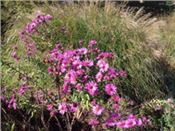Plant Asters For Unique Display Of Fall Color

There are 180 species of aster, many of which are native to Illinois. These fall-blooming dainty, daisy-like flowers range in color from purple, white, pink, and red, all with bright yellow centers.
Photo by Kelly Allsup
URBANA, ILL.
Fall gardens may need some added pops of color this time of year to maintain beauty and diversity until winter arrives. Asters are a late- blooming, pollinator friendly flower that looks great in the garden and in a fall floral display.
“Think beyond the obvious, fall-blooming favorite mums this year,” says Brittnay Haag, University of Illinois Extension horticulture educator serving Livingston, McLean, and Woodford counties. “Select a gorgeous, full-of-color aster instead.”
There are 180 species of aster, many of which are native to Illinois.
Their dainty, daisy-like flowers range in color from purple, white, pink, and red, all with bright yellow centers. New England aster, Symphyotrichum novaeangliae, and aromatic aster, Symphyotrichum oblongifolium, are two easy-to-find favorites.
Asters grow best in full sun to partial shade areas with well-drained soils. They are typically perennials in Illinois gardens, but need to be in the ground at least six weeks before it freezes to develop a good root system and overwinter successfully.
Varieties can vary in height from 6 inches to 6 feet. Taller varieties can be pruned back by a third several times throughout the summer, stopping in late July, to create a more compact plant. This will also increase the number of blooms on the plant.
Asters will begin to bloom when the days get shorter in late summer to early fall. They are short-day plants, like mums, meaning they need long periods of darkness to initiate flower buds.
“Beware, it is normal for the lower leaves to turn brown and dry up when the plant is in full bloom,” Haag says.
To prevent asters from self-seeding throughout the garden, cut back the plant to about 2 inches above ground level after the first hard frost has turned the foliage brown. Gardeners can also choose to leave the plant and developing seeds for winter interest and for the birds to enjoy.
To keep asters tidy and healthy, divide the plants in early spring every two to three years, or when the center dies out. Some varieties are unfortunately prone to powdery mildew, which can be reduced with good air circulation and watering in the morning at the base of the plant.
“A bee and butterfly favorite, asters are a great source of fall nectar for pollinators traveling on their fall migration,” Haag says.
“While most flowers have already finished blooming, asters are just starting their show in the garden.”
They serve as the larval host plant for several butterflies and moths, including painted lady butterflies.
Asters also make great cut flowers for mixed fall arrangements.
Arrange them with bright yellow goldenrod and ornamental grasses for a stunning autumnal décor display. ∆